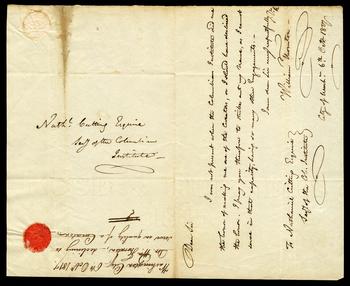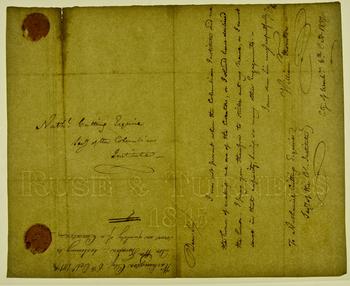One of the more exciting things I have been working on in the conservation lab of the Smithsonian Institution Archives over the past year has been to photograph the imaginative and beautiful watermarks found on our collection of archival documents. For centuries, papermakers have been twisting thin wires into whimsical shapes, from unicorns to complicated crests with lions, swords and crowns, and imprinting their designs onto the paper during the paper making process. What makes watermarks so fascinating is that they are like secrets hidden in the paper, invisible except when held up to the light, giving us clues as to where and when the paper was made.

Why would papermakers bother to include these fanciful and superbly executed shapes in the paper, especially if you cannot see them very well, you may wonder? While their original purpose remains a mystery, it is widely believed that watermarks were used as the papermaker’s trademark and to indicate the size and quality of the paper. Especially fancy chiaroscuro watermarks were even used to promote the superior quality of the artisans of certain workshops. More thrilling, perhaps, is that it is also thought some were used as symbols of secret brotherhoods and were used to identify their members.

Today, many of us are probably most familiar with the term watermark from its carry over to the digital realm as a "digital watermarking," where interestingly, no physical watermark exists or water for that matter (rather a sequence of codes embedded into electronic documents and images)! As for traditional watermarks, at present we are likely to encounter them mostly in our currency, government documents, and more as a security device.
Many of the watermarks in our collection are from American papermills, which tended to favor images of doves, eagles, tobacco plants, post-horns, stars, and lambs. It may seem odd to us now, but there was a time in America before the 1800s when foreign papers, with their watermarks of Britannia and the crown, were considered far superior to domestically produced paper. By the 1800s, though, paper with unique American watermarks had found their way into the hands of the most famous scientists and politicians, such as John Quincy Adams and Thomas Jefferson.
Sadly, with the advent of large scale paper manufacturing at the end of the 19th century, the ancient craft of making paper by hand nearly came to an end in America. The art of watermarking all but vanished and the tradition was on the verge of collapse. Enter Dard Hunter, born on this day in 1883 in the town of Steubenville, Ohio. A gifted artist and craftsman, Hunter was a leader in the Arts and Crafts movement and revived the art of handmade paper making. His knowledge and experience led him to write the most comprehensive history of western papermaking of the time. To celebrate Hunter’s birthday, I would like to share with you a sampling of the watermarks I have captured in our watermark gallery below above. An examination of our watermarks will lead you through the fascinating history of American papermaking. It is an ongoing project and I will be adding interesting watermarks to the site often, so keep checking!
You too can make paper the way they did thousands of years ago or learn how to make watermarks.
Related Collections
- Record Unit 7051 - Columbian Institute, Records, 1816-1841, with related papers, 1791-1800, Smithsonian Institution Archives
Produced by the Smithsonian Institution Archives. For copyright questions, please see the Terms of Use.


Leave a Comment